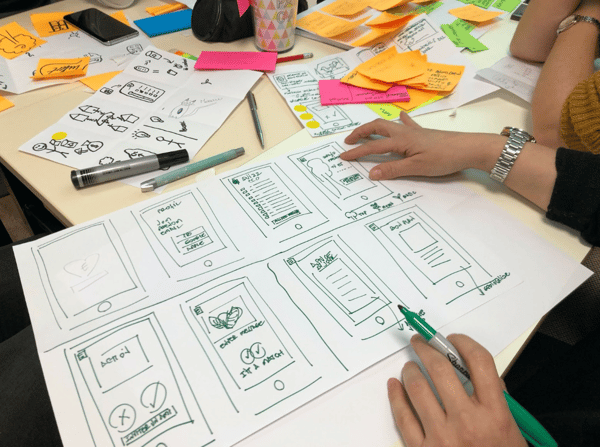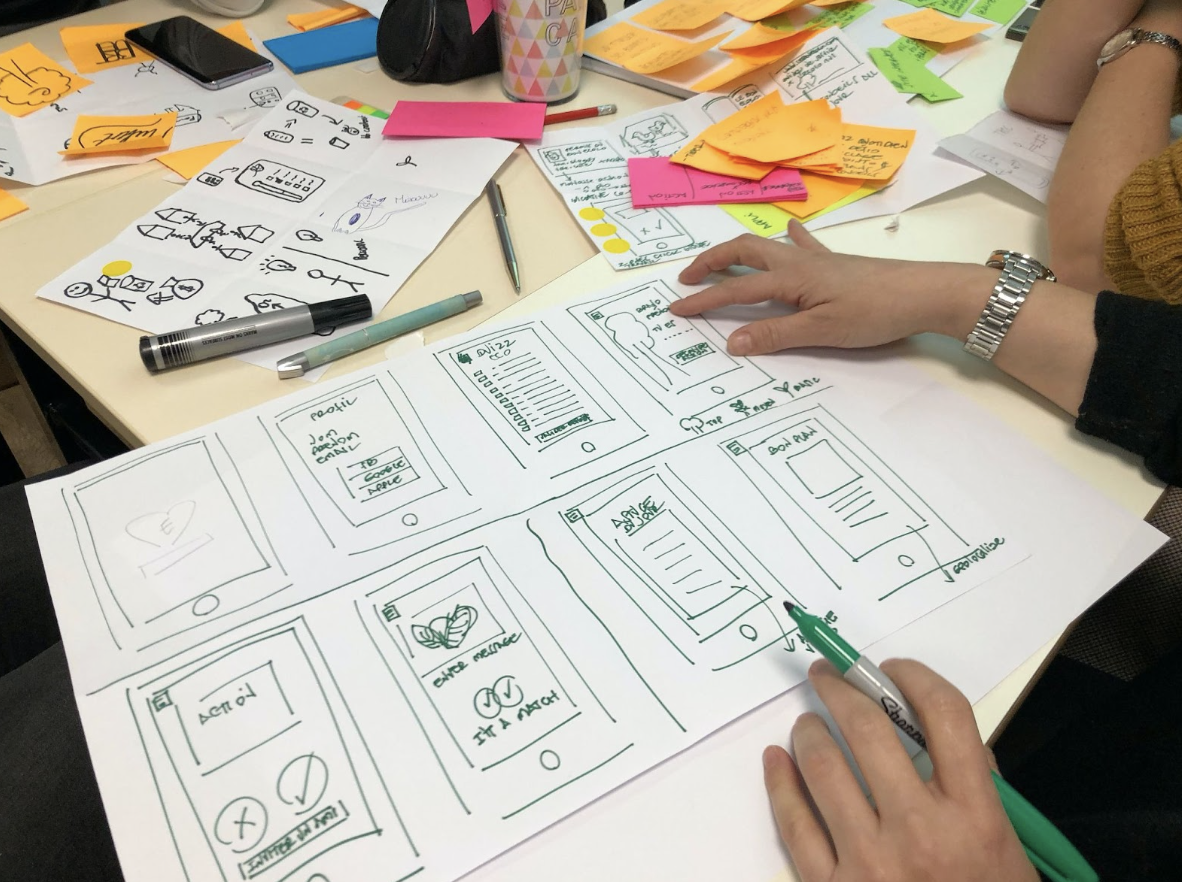Ideation is usually one of the most engaging and thrilling stages for designers during the design thinking project. The ultimate aim of ideation is to create a hefty collection of new ideas which can be filtered and selected to inspire innovative product designs and offer practical solutions to existing problems.
What is Ideation – and How to Prepare for Ideation Sessions
In simple words, ideation is the name given to the creative and innovative journey of creating and communicating new concepts and ideas. It may also be called ‘innovative’ thinking, which is usually directed toward finding solutions to an existing problem. Ideation may also help you come up with more effective approaches to completing activities. From generating new ideas with a rigorous thinking process to developing and maturing them further and finally coming up with a steady approach to putting them to practice, ideation is an all-encompassing and diverse concept.
Ideation Will Help You:
- Ask the most valid questions and encourage innovation by focusing your activity on users' needs and your knowledge of them.
- Move and think beyond the stereotypical solutions by unleashing the maximum innovative potential.
- Amalgamate and make the best of your core strengths and the variety of perspectives of the team.
- Turning volume and variety into creativity and innovation.
- Focus on out-of-the-box thinking, leaving aside all generic solutions and opting for the best ones.

Why Do We Need Ideation in Design Thinking?
Ideation is not just about questioning assumptions and asking "stupid" questions. It's a process that involves digging deep into users' needs and desires during Empathize and Define phases. From there, you can move on to creating innovative solutions that respond to their unique needs using various ideation techniques. Therefore, if you want to create exceptional products or services, ideation is an essential step that you cannot overlook.
Get Started in Applying Ideation Methods
Facilitating ideation can be a daunting and intricate undertaking. It requires expertise in understanding and managing teams, human behaviour, and the ability to adapt and be flexible. These skills can be challenging to acquire and refine. However, don't be discouraged! Experience is the ultimate teacher and guide in any field. The most effective way to learn is by absorbing the theory and techniques from experts and testing them in your own environment. Tweak and tailor them to meet your specific requirements and you'll be well on your way to mastering the art of ideation facilitation.
How to Prepare Before You Start Ideating
- Empathize
- Define
- Ideate
- Prototype
- Test
1st Mode: Empathize
The two initial stages of design thinking are especially valuable in preparing for the ideation session with your team. The first of these is the "empathize" mode, which focuses on conducting rigorous research and observations. From closely observing users and connecting with them to conducting observations through field studies, the "empathize" mode prepares you for the ideation journey.
2nd Mode: Define
Defining is the phase where you take all the valuable insights you gained during the Empathise mode and transform them into a clear and concise problem statement. This step involves connecting the dots, identifying patterns, and utilizing creative methods such as Affinity Diagrams, Sharing Inspiring User Stories and Personas to unearth deeper insights about your target audience.
In order to learn about the information that you need to get started, here is a perfect guide for you in the form of user stories.
By the end of Define mode, you will have developed a point of view (POV) that will help you focus on the crux of the issue, making it actionable and meaningful. This process paves the way for creating solutions that have real impact and connect you with your audience on a deeper level. Throughout the ideation process, the problem statement serves as a guiding framework that allows you to focus on user-based insights.
How do you define your Point Of View?
Step 1
The process of developing a problem statement or POV begins with defining the user. Developing one or more personas using affinity diagrams, empathy maps, and other methoads will help you gain a deep understanding of your target audience. These methods help you crystalize your research results, including observations, interviews, and fieldwork, and identify the most important needs to fulfil. Remember, these needs should be expressed as verbs to highlight the actions your users want to take.
Once you have identified the most important needs of your users, you will need to work on synthesizing the information gathered during Empathise mode to develop powerful insights. These insights should not just be a reason for the need, but rather a statement that reveals a deeper understanding of your users' needs. By expressing these insights, you will create a foundation for developing design solutions that fit your users' needs and resonate with them.
Step 2
Use a point-of-view template to place your definitions within. Here is an example of how your template should look like.
|
USER |
|
|
NEED |
|
|
INSIGHT |
|
Step 3 – POV Madlib
An optimum POV can be best expressed using the amalgamation of three elements: user, need, and insight. This will ultimately result in a realistic and practical problem statement which will pave the path for the rest of the design activities. It becomes absolutely convenient when you simply have to input your findings into a Madlib as shown below. A point-of-view can be generated and articulated in no time by inputting the required information in the format below:
[user … (descriptive)] needs [Need … (verb)] because [insight … (compelling)]
Step 4 – Make Sure That Your Point Of View is One That:
A well-crafted POV provides a narrow focus, framing the problem as a problem statement. It inspires your team and guides your innovation efforts, ensuring that you're working towards a common goal. A compelling POV also helps you evaluate competing ideas, informing the criteria for selecting the best solutions.
As you evaluate competing ideas, we think it might be helpful for you to check our recent blog post to learn more about conducting competitive analysis.
But a great POV is more than just functional - it's also sexy! A captivating POV captures people's attention, drawing them in and igniting their imagination. A well-crafted POV is valid, insightful, actionable, unique, narrow, meaningful, and exciting - a true reflection of the design thinking process itself.
So, whether you're working on a product, service, or experience, make sure that your POV is more than just a problem statement. Craft it carefully, making it engaging and inspiring, and it will be the key to unlocking the full potential of your innovation efforts.
3rd mode: Ideate
After the creation of your POV is done, the next step is ‘ideate’. The starting point is always the problem statement or the point of view. Break down the daunting challenge into easy-to-accomplish, actionable targets. It is particularly helpful to consider the ‘how might we’ perspective to complete your sentences and ideate.

“How Might We?” Questions Frame and Open Up Your Design Challenge
Rather than saying that we should design this product or that, the concepts of design thinking allow you to leap onto the ideation technique and ask ‘how might we…?’. This simply involves reframing the point of view into a question.
Examples of How to Generate HMW Questions Which Fuel your Ideation Sessions
In the midst of the ideation process, you should try to be as open to ideas as possible. You can generate ‘how might we’ questions by breaking down your POV into practical, actionable, and smaller chunks using some of the helpful advice below:
It's time to step up your game and ask the right questions to spark your creativity! Don't fall into the trap of narrow thinking, like "How can we create a self-driving taxi?" or overly broad ideas such as "Let's redesign transportation!"
Instead, try asking inspiring and specific questions that serve as a lodestar during brainstorming sessions. For example, "How could we design a driverless car that is not only environmentally friendly, but also affordable and easy to share with others?"
Once you have your fundamental question, it's time to break it down into smaller, actionable sub-questions that will guide your ideation sessions. Ask yourself things like "How can we design an electric car?" and "What if we created a car with a digital key code that is secure for sharing among multiple users?"
With the right questions, you can unlock creativity in your ideation process that you didn't know you had.

Best Practice Guide to Asking How Might We
So, How Might We break down that larger challenge into smaller, more actionable questions?
It is essential to start with brainstorming five to ten HMW questions that address your POV. There is no need to worry about solutions just yet, the key should be to generate meaningful questions that will guide your ideation sessions.
Next, look at and carefully analyze "How might we" questions. Do you think they are too narrow and limit possible solutions? Or are they too broad and leave you with no clear starting point? If they are too narrow, it is always possible to broaden them to accommodate a wider range of ideas. If, on the other hand, they are too broad, simply narrow them down to focus attention without stifling creativity.
Once you've fine-tuned your “How Might We” questions, you'll have a launching pad for your ideation sessions. So, get ready to explore wild ideas and generate innovative solutions that will take your problem-solving skills to the next level!
Characteristics Required for Successful Ideation
- Start by cultivating a mindset that accepts change and welcomes new input. Be willing to adapt your thinking as needed, to see things from different perspectives and to broaden your understanding.
- Then, practice connecting seemingly unrelated concepts, themes and attributes, which will allow you to create new possibilities and break down barriers.
- Next, work must be done to disrupt common beliefs, assumptions and norms, rethink conventional approaches and challenge the status quo.
- And when you encounter deadlocks or dead-ends, don't give up - flip them over and see them from a different angle, or change direction altogether to find new opportunities.
- But don't stop there - let your imagination run wild, dreaming up new realities and inventing bridges to get there.
- And finally, be experimental - take risks, try out new ideas, and don't be afraid to venture into unknown territories.
With these skills and mindset in place, you'll be well-equipped to tackle any challenge that comes your way!
Frequently Asked Questions
What is ideation with an example?
Ideation refers to the process of generating new ideas or concepts. It involves brainstorming, exploring, and evaluating various possibilities to solve a problem or create something new. For example, a group of entrepreneurs ideating on a new app might consider user needs, market trends, and technological advances to come up with innovative features and designs.
What does ideation mean in psychology?
In psychology, ideation refers to the process of generating, developing, and expressing new ideas or concepts. This cognitive process is important in problem-solving, creativity, and innovation. Ideation can be influenced by various factors such as personality, culture, environment, and cognitive abilities.
What is a synonym for ideating?
A synonym for ideating is "brainstorming."
Check out Harvestr for a variety of other informative articles for you.
